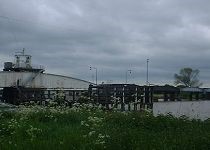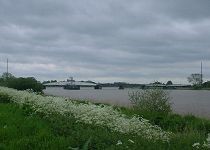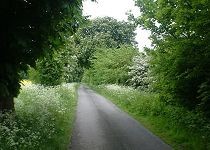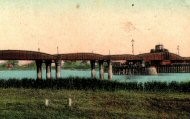Skelton
"farmstead on a shelf or ledge", Old English scelf (with Scandinavian sk-) + tun.
"A Dictionary of English Place-Names", Oxford University Press
Skelton is strung out along a narrow road which follows the bend of the Ouse. All the houses have nice views of the concrete wall which protects them from the swirling river.



The Hull to Doncaster railway crosses the river at Skelton via the huge Goole Swing Bridge. As with all the villages around here, the roads are a pleasure to cycle along. They are usually free of traffic and surrounded on both sides by trees.
Postcards

Visitor Comments
Posted by Norma on 14/03/2008
Looking for relatives of Mary SMART, said to live in Skelton during 1860-1870 or thereabouts. Was in service at Saltmarshe Hall around 1860-1870. Married Henry Wood, lived in Goole on Carter Street. Had five or six girls, my grandmother being the first one Sarah or Sally. Thanks.
Posted by Jane on 27/11/2009
My grandfather was born at Manor Farm House, Skelton in 1870. Has anyone a photo of the house or any info about it? Thanks.
Posted by John on 13/12/2009
Skelton had a couple of shops to serve the population in my youth. One was at the end of Jenny Lane and formed part of a block of houses which looked out towards Wards Staithe on the riverbank. The whole block is now offices for the "new" jetty and yard. Following this block was a terrace of houses (still standing) then a larger house set back, and a couple more houses attached to the Jolly Sailor Pub, a Hull Brewery inn. Horace Prince held the licence right through my formative years and Horace together with his sons Bill and Jimmy supplemented the family income as window cleaners and chimney sweeps over a wide area around Howden, Howdendyke, Kilpin and Skelton.
Next to the Jolly was an open space which in the past had been Skelton Shipyard. As a boy I saw old disused wooden derricks in the yard and metal rails running across the road from the yard, through a planked gap in the bank to the river's edge. We were told the ships used to be launched off these. Next to the shipyard was a row of houses, now demolished and replaced. Dick Abbey lived in one of the old houses but I do not recall which.
There was a gap of a couple of field's width before the next houses which were alongside a grass lane, connecting to Jenny Lane. This group of house was known as Crow Trees and I think one was occupied by Jack Carter. Another field then the old chapel and a couple of houses, one of which was occupied by Johnny Jackson.
Yet another gap then Clough corner followed by a series of farms with Bill Clayton's being the first. As I recall these were much spread out with several gaps between them. All the gaps are now filled in with new houses right along the way to the block of houses which contained the other shop "Henry Claydons". Henry was also a basket maker and had a shed down a lane behind the houses where he practised his trade. I recall he had a daughter Molly who sometimes served in the shop. After the block with the shop was a terrace of houses before the next gap of open fields followed by a farm which in later years was occupied by Rob Jarred. At the end of the village was (and still are) the railway houses attached to the Swing Bridge.
Beyond the railway was the Sandhall estate but that's another community.
Posted by Corby on 15/12/2009
Although I never lived that side of the river, your posts on the area of the villages have brought back many memories. My friends and I used to use the Jolly Sailor pub but before that, fishing at Kilpin Pond for roach or perch - once caught returning them to the water. We would visit my friend Derek Cutts's grandma, Mrs Wheldrake, who lived quite close to the pub. I also remember a candlestick she had which was made from the metal with which the R100 was built, for Derek's mother worked for Barnes Wallis and his father for Neville Norway Shute.
My own father spent many clandestine visits on the Saltmarsh estate between the wars. People called it poaching but I would like to rephrase it and call it surviving. Of course my main interest in the area now is to find out more about the shipbuilding that went on in the mid-19th Century by Banks and Caisley. On the 1871 census of Skelton there was Bridge Cottages, six in all. The families were J. Milust (gardener), W. Coultard (agricultural labourer), R. Hales (engineer), C. Cook (engineer - my great-grandfather), J. Hope (engineer) and T. Gill (signalman).
My wife was taught music by your aunt Jessie at the Modern School and always remember her for turning up riding a motorbike, quite trendy now, but a living a bit before her time then. A trend setter! I always remember me allowing my wife (then my girlfriend) to ride my Triumph Speed Twin along Westfield Banks. She went off quite easily on her own but when I climbed on the back, we both came off laughing. Happy days.
Posted by John on 15/12/2009
Was the Banks and Caisley shipyard you mention the same one I recall next to the Jolly Sailor? This would be about opposite the old Cleveland oil storage tanks which were on the Hook side but are now demolished and houses built on the site.
As to the music teaching it would be my aunt Judy rather than Jessie (maybe the pupils called her Jessie as most of us Jessops got that as a nickname at some time or other) who taught at the Modern School. She had a motorbike but changed to driving a car in the 1950s. Her first car was an Austin A30 then some years later she changed to an A35.
Posted by Corby on 16/12/2009
My wife agrees Judith sounds right. A good choice for her first car. The yard in question was the one you described next to the Jolly. My interest lies in the fact that the ships built there were special. They travelled worldwide and there is very little being put down on paper to carry on their memory or the men who sailed them and also built them. I remember seeing on the walls of the Jolly photos and sketches, so some made an attempt to capture the moment for posterity.
Posted by John on 07/01/2010
Sandhall Estate lies beyond the railway bridge at Skelton. When I was young I used to occasionally cycle through the park and onwards to the riverbank. The first thing you came across is the gate across the road with a gate lodge alongside it. Passing through this gate you entered the park and before long encountered a second gate. Through this gate was the area surrounding the hall with the main house on the left. Facing this on the right was the old stables block followed by a number of estate workers cottages which backed onto the riverbank.
Continuing along the road there was a third gate giving access to the park grassland with yet another (fourth) gate where the grass field finished and arable land started. Some way down this road was the farm and buildings with a couple of tied agricultural workers cottages facing it. Neville Thompson was farm manager for the estate around the 1970s.
The road carried straight on until it ended at the last farm which was at the riverbank. During the 1950s some refugees from the Hungarian uprising came to live at this last farm. I recall the children starting at Howden School unable to speak much English but they learned pretty quickly and soon settled in.
The estate was owned by the Schofield family at that time and Mrs Schofield was quite a character. She would cycle from Sandhall to the shops in Howden, sitting very erect on her bicycle wearing a long tweed skirt and the bicycle had panels covering the back wheel to prevent this skirt being entangled in the spokes. She made a point of always greeting folk she met including children.
I have not been down to Sandhall for some years now but I believe the last farm fell into dereliction and may not exist today.
The old school in Skelton became the E P Schofield Memorial Hall.
Posted by John on 10/01/2010
Kilpin seems to have been lumped in with Skelton but was actually a completely separate community spread out along a couple of miles of road. During the 1950s it started at Elm Tree corner where there was Elm Tree House and Elm Tree Gardens where my father grew tomatoes and cucumbers etc. A little way along was Elm Tree Farm on the junction with Bellcross Lane. This was owned by Ernest Austwick and his sister Mabel. Also living there was an ex-German prisoner of war George Richnau. A couple of hundred yards further on the right was Elm Tree Bungalow, occupied by Claude Baines and his wife.
Continuing further, on the left was Pollards Pond which had a house and wind pump that pumped water to the chemical works and also supplied a number of chemical works houses along the way. Tommy Pollard allowed people to fish in this pond for the princely sum of 3d a day. In the summer he sold bottles of lemonade to fishermen. Access to the pond was via a track alongside Sunny Bank which was a group of five cottages. Ken Jackson lived in one, a woman known as Beattie in another and at the front lived Joe Otter and family and Cliff Coulthard and family.
Next was another pond with house and greenhouses belonging to Chris and Madge Kettlewell who also grew tomatoes and were friends of our family. Their pond was not open for fishing but I was allowed to fish there a couple of times.
Some distance further on were a couple of cottages. In the first, next to a grass lane, lived Barry Watsons family but I can't recall who lived in the second. The road curved round into Kilpin village proper after that with the new hall on the right, occupied by Longthorpes. They owned the farm opposite.
A tee junction next with the road to the left going to Balkholme over the common with wetland and trees at each side of the road which was said to belong to the freemen of Kilpin but no-one knew who they were. From the common end of the road the first house was Dairy Farm, occupied by George Grandin who had been an Italian prisoner of war who stayed on when the war ended. Next was Harold Johnsons farm, then Les Camplejohns. Les was a keen pigeon fancier and won many races with his birds. At the other side of the road was a chapel which has now been converted into a house, Jenny Lane, which runs through to Wards Staithe at Skelton, Eric and Bernice Wards farm which eventually was bought by Moses Oates and became Garden King Frozen Foods for a time. Between this farm and the hall were three or four cottages which I believe were tied cottages for the hall farm. Much further out of this group of houses and farms was a lone house (now demolished and ploughed out) on the junction with Skelton Broad Lane but I can only recall this as derelict, however it did have a crab apple tree in its garden. The fruit was completely inedible it was so sour!
Posted by Caroline on 15/05/2010
When we used to walk to Skelton to Henry Claytons shop, I always used to think that the path resembled chocolate squares. I can remember them making baskets there as well. We got our dog from them, bless him he died many years ago and his resting place is at Howdendye where Mr and Mrs Smith's house is still standing at the side of the river.
Posted by Phil on 17/05/2010
I know what you mean about the blocks of chocolate. The path alongside Henry's shop. His and Annie's daughter still lives in the house next door. Do you remember having to ring the bell?
Posted by Caroline on 16/12/2010
Yes, I remember having to ring the bell. We would also think nothing of walking up to see Rose Bains and her family at the gate house going on to Sandhall Park. We used to love to go exploring in the wood then for dripping and bread. Would kids walk that far for sweets now I wonder?
Posted by Rebecca on 01/06/2014
Henry Claydon is my grandfather and I love to hear the memories people have of his shop. My dad Kenneth Claydon was born in that shop and my Auntie Molly lived in the house next door.
Posted by Caroline on 06/04/2011
Has anyone got any info on my grandad Charlie Newman or Kitty Newman, so I can add to my tree? Thanks.
Posted by Rowland on 03/03/2016
Charlie and Kitty had four sons John, Sid, Charlie, George and two daughters
Posted by Lucy on 29/10/2013
I have just moved back to Skelton. I was born here in 1950 at Crow Trees. My parents were Jack and Alice Carter and my sister Margaret. I have such good memories of my childhood in Skelton, and the people who lived here, I knew everybody in every house, what lovely people. I have moved to School House, which I have a photo of my Grandad Keeble outside of one of the houses dated 1928. Granny Keeble was caretaker at the village school, which my cousin Bob Lightowler attended when he was a boy.
Posted by Barry on 13/01/2014
So pleased you have become a Skeltonite once again. You went out with John Muttock when we had motorbikes together, along with my cousin Brian Sweeting. I left Skelton when I was nineteen and went to live in Norfolk, but 46 years later still refer to Skelton as home. So many lovely memories of Skelton and surrounding villages. I'm the same as you could name everyone who lived in the village
Posted by Lucy on 04/02/2014
Barry, I remember the motor bikes, Mike Pitter and Rob Sherburn also had bikes. Your mum Betty went potato picking with my mum I think? They worked hard in those days. I love this village, I've had fifteen moves and gone full circle back to Skelton, it's definitely the last move.
Posted by Barry on 06/02/2014
Yes you're right about mum pot picking with your mum. That generation worked hard as you say. I've got some great memories of growing up around Skelton and surrounding villages. Wag Pitter and Rob Sherburn had bikes, great days.
Posted by Laddie on 28/12/2016
Where have the last 50 years gone?
Recently I cycled around and through Laxton/Skelton/Howdendyke and, although the inevitable changes gave my journey a sense of "oh my, what's happened…" it was so nice to "be back". It seemed like yesterday! I smiled and talked to myself like a nutcase! Remembering the romance that once was. What a great place to be "in". I've "been around the block" but would give my right arm to "be back"
Posted by Corby on 01/10/2017
In my family records is a census taken at Bridge Cottage Skelton. My grandfather Joseph Auckland Cook was five years old and his father Charles was the engineer working on the bridge.
I recently visited the site and was cordially invited in. The two end cottages are no more, the remaining four are now two. I was shown how small these homes were - the overhead beam indicating the area lived in, with the original fire place.
Back to Table of Contents
feedback@goole-on-the-web.org.uk